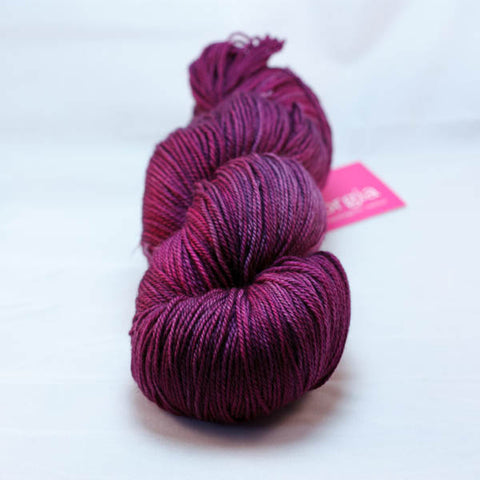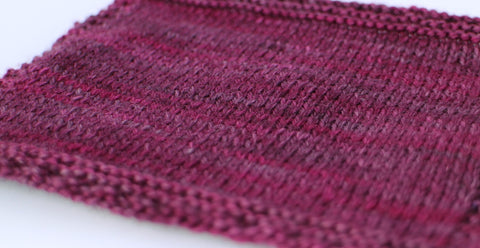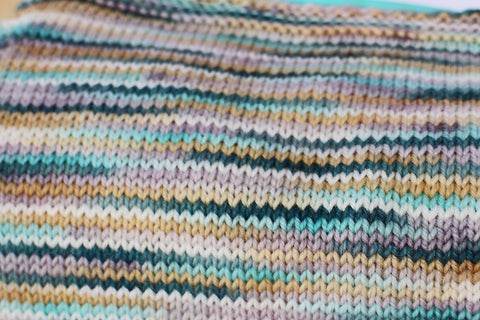Patterns
Notions
Gifts
Selecting Yarn For Socks
April 03, 2015 6 min read
A Review of SweetGeorgia Tough Love Sock, Manos Alegria and Schoppel Wolle Zauberball.
Not all sock yarns are created equal and with a dazzling array of brands, blends and colours to choose from, knowing where to start can prove challenging. Even yarns that are labelled as ‘sock yarn’ may not always be the optimal choice for your project. On the plus side, some yarns that are entirely suitable for socks can also work very well in accessories and garments, particularly those which need to be able to stand up to a little wear and tear.
Choosing a sock yarn is as personal a choice as your knitting needles or even your technique. What works for some will not for others, particularly when taking a sock suitable blend and using if for accessories or garments which sit next to more sensitive skin, such as that on the neck.
There are several considerations to bear in mind when selecting a yarn to try, which Clare Devine covers in more detail in her blog post "Getting Started with Socks"
- Durability. If you want your socks to wear well, you’re going to need some reinforcement. This usually takes the form of synthetic materials such as nylon. This adds strength and stretch, two sought after properties when it comes to socks.
- Bounce. As mentioned to above, you need a yarn with a decent amount of bounce, to give it the stretch it needs when using it for socks. No stretch means baggy, uncomfortable and ill-fitting socks, or worse, a sock you can’t even get on.
- Purpose. What’s the purpose of your sock? This will drive your decision-making process. Super warm bed socks work great in alpaca but won’t have the stretchy properties you would get from a merino/nylon blend. If you need a compromise, select a composite yarn that mixes smaller amounts of different materials to create a happy medium.
- Care. If time and convenience top your requirement list, choose a machine washable yarn. All machine washable yarns can be hand washed, the reverse is not true, so take care! Use an appropriate cleaning product to care for your woollens, such as Soak, which can be used both in the washing machine and for hand washing.
To help you along your way a little, I’ve test-driven three popular brands of sock yarn, sourced from across the globe: SweetGeorgia Tough Love Sock from Canada, Manos Alegria from Uruguay and Schoppel Wolle Zauberball from Germany. These yarns come in an array of shades and dye techniques, giving lots of options when it comes to selecting a colour scheme for your project.

Sweet Georgia Tough Love Sock
This is a hand-dyed, 80% merino, 20% nylon, fingering weight 3ply blend, supplied in 115g skeins and shown here in the colourway ‘Mulberry’. This is a rich shade of purple, with lots of tonal variation within the yarn from flecks of warm magenta to cooler blackcurrant elements. This gives an interesting depth to the knitted fabric, perfect for enhancing subtle detail in patterns.
With 20% nylon, it will stand up well to wear, in addition to adding structure to the fabric. It has a standard to high twist, so it is well worth swatching with different sized needles prior to starting a project. For socks, it may be pertinent to decrease the needle size to create a harder wearing fabric and adjust the size to accommodate this; for garments, which this yarn would be entirely suited to, test the fabric when knitted at the recommended gauge for the project.
Project-wise, with crisp stitch definition, found when knitting this yarn, consider designs with some textured or cabled details. A colour way with this kind of depth would be best paired with larger scale details such as cables that are at least 2cm wide on a sock. For lighter, airier shades, more delicate details can be incorporated.
In terms of handle, it’s not the softest yarn in the skein of the three yarns, despite having the highest merino content yarns. It also is a little firmer in the knitted fabric. That said, with these properties, one gains better stitch definition for textured detail as well as being harder-wearing.

Schoppel Wolle Zauberball
German sock yarns, on the whole, are an excellent choice when it comes to selecting durable, colourful and fun yarns which can stand up to a little abuse. Schoppel Wolle is no exception to this, and if you are a fan of self-striping or patterning yarns, this could become a go-to yarn for you.
Supplied ready wound, Zauberball is a 75% merino, 25% nylon, single-ply, fingering weight yarn, which comes in 100g balls and is shown here in the colour way “Smoke Signal’. This is a tonal, self-striping (bordering upon gradient) dye style, with gently shifting, long colour repeats from light wedgewood through to navy.
It has 25% nylon, giving it a robustness that makes it suitable for socks, yet being single plied, it creates a lovely soft knitted fabric with a light halo. The self-striping pattern means it’s interesting to knit; simply cast on some plain socks and watch the colours change.
After blocking, this yarn blooms beautifully, giving a lovely matte texture to the knitted garment. This will soften the lines of any textured details in your projects. It would be an excellent option paired with other singles yarns in stranded colourwork projects, to give the appearance of lots of colour changes, without the need to change yarns or weave in ends. In comparison to the other two yarns, Zauberball lacks the high-definition found in yarns with a higher twist or multiple plies. That said, it produces a softer and lighter fabric, which would be suited to garments as well as socks. It retains strength from the high nylon content, making it a good all-purpose, workhorse yarn.

Manos Del Uruguay Alegria
Dyed by hand by co-operatives supporting women in rural areas of Uruguay, Alegria is a 75% merino, 25% polyamide two-ply, fingering weight yarn, supplied in 100g skeins and shown here in the colourway ‘Atantico’. It’s a variegated colourway, with short colour repeats of mint, grey, teal, sand and natural sections.
This yarn has a high nylon content, yet a very soft handle in the skein, as the spin is on the looser side. This means that a tighter gauge may be required if using this yarn to knit socks to increase durability. That said, the knitted fabric is plump and comfortable, making this yarn entirely appropriate for less heavy duties. It would make excellent shawl and accessory knitting material, provided patterns were carefully chosen to show off the colour changes to best effect.
Patterns containing high levels of detail may become lost with variegated yarns, so keep any texture pared back to avoid competing with the colour way. Swatching for the project is important to establish where colours may pool; to break pooling up, simply begin knitting with the other end of the ball, or another ball of yarn if using more than one skein. Alternatively, celebrate the little clusters of colour if you enjoy them – they can make really interesting features on otherwise plain socks.
When compared to the other two yarns, the Alegria has a softer handle and a looser spin. This would make it more suitable for accessories and garments, although it would be strong enough for socks subject to lighter wear. Decreasing the gauge would increase durability, so swatch for your projects with different needles sizes to compare the resulting fabric.
Summary
When choosing yarn for your project, many different factors come into play, even when choosing yarns that are all suitable for knitting socks. Think about the desired end properties of the piece, and use these to shape your decision-making process. If you’re unsure, try swatching at different gauges to better inform you of how the yarn will come out. And remember, if all else fails, you can rip it out and let the yarn become a whole new project!
About the Author
 Jo Milmine is a podcaster and blogger based in Scotland. She co-owns The Golden Skein, the company that brings meticulously curated luxury yarn clubs showcasing the finest hand dyed yarn the world has to offer.
Jo Milmine is a podcaster and blogger based in Scotland. She co-owns The Golden Skein, the company that brings meticulously curated luxury yarn clubs showcasing the finest hand dyed yarn the world has to offer.
Through her bespoke consultancy business, Jo works closely with independent dyers, sharing her business and yarn expertise and supporting them to achieve their goals.
Passionate about crafting (and comedy knitting patterns), you’ll find her podcasting as Shinybees, as well as on Ravelry, Twitter & Instagram.
Recent Articles
Subscribe
Sign up to get the latest on sales, new releases and more …






